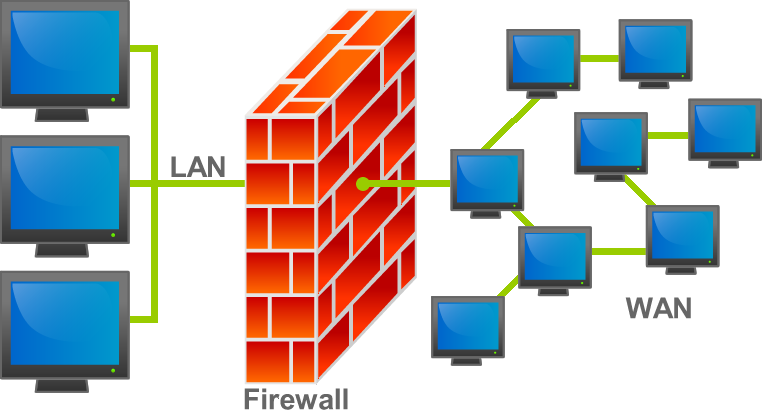Types of Firewalls: Types, Features, Pros & Cons, and Major Brands
Firewalls are the backbone of network security, serving as the first line of defense against cyber threats. Whether you're securing an enterprise or a small business, understanding the different types of firewalls, their features, and the companies providing them is essential for making the right decision.
In this comprehensive article, we’ll explore:
-- Types of Firewalls
-- Key Features
-- Pros and Cons
-- Top Firewall Providers and Model
What is a Firewall?
A firewall is a network security system that monitors and controls incoming and outgoing traffic based on predetermined security rules. Firewalls are essential in preventing unauthorized access and ensuring that only legitimate data traffic passes through the network.
Types of Firewalls
Firewalls come in different types, each designed for specific use cases and security needs. Here’s a breakdown of the major types:
-
Packet--Filtering Firewall
How it Works: Examines individual packets of data passing through the firewall. Filters traffic based on IP addresses, port numbers, and protocols.
Features:
-- Simple and fast filtering.
-- Low resource consumption.
Pros:
-- Easy to configure.
-- Effective for basic security.
Cons:
-- Limited to basic filtering.
-- Cannot inspect packet contents (payload).
Top Brands:
-- Cisco: Cisco ASA
-- Juniper Networks: Juniper SRX Series
-- MikroTik: RouterOS
-- pfSense (Software): Open--source packet--filtering firewall
-
Stateful Inspection Firewall
How it Works: Tracks the state of active connections and makes filtering decisions based on both the state and the IP addresses/port numbers.
Features:
-- Monitors entire sessions rather than just individual packets.
-- Filters based on connection state (e.g., new or established).
Pros:
-- More secure than packet--filtering.
-- Better protection against attacks like IP spoofing.
Cons:
-- Higher resource consumption than packet--filtering.
-- Can be slower with large traffic loads.
Top Brands of Firewalls:
-- Cisco: Cisco ASA with stateful inspection.
-- Fortinet: FortiGate.
-- Juniper Networks: SRX Series.
-- pfSense (Software): Offers stateful inspection.
-
Proxy Firewall (Application--Level Gateway)
How it Works: Operates at the application layer, acting as an intermediary between the user and the internet, filtering traffic based on specific applications.
Features:
-- Can inspect content within packets (deep packet inspection).
-- Supports user authentication.
Pros:
-- Provides deep inspection and granular control over traffic.
-- Can block malicious content or applications.
Cons:
-- Slower performance due to deep packet inspection.
-- Requires more resources than other firewall types.
Top Brands:
-- Blue Coat (Symantec): Blue Coat ProxySG.
-- F5 Networks: F5 BIG--IP.
-- Squid (Software): Open--source proxy firewall.
-- McAfee: McAfee Web Gateway.
-
Next--Generation Firewall (NGFW)
How it Works: Combines traditional firewall features with advanced capabilities like intrusion detection and prevention (IDS/IPS), deep packet inspection (DPI), and application control.
Features:
-- Application awareness and control.
-- Integrated threat prevention (malware, ransomware).
-- Deep packet inspection and SSL decryption.
Pros:
-- Comprehensive security against advanced threats.
-- Can identify and block specific applications or content.
Cons:
-- More expensive than traditional firewalls.
-- Requires complex configuration and management.
Top Brands:
-- Palo Alto Networks: PA Series.
-- Fortinet: FortiGate NGFW.
-- Cisco: Cisco Firepower.
-- Check Point: NGFW with integrated IPS.
-
Unified Threat Management (UTM) Firewall
How it Works: A multi-functional firewall that integrates various security features such as antivirus, anti-malware, web filtering, and intrusion prevention in a single device.
Features:
-- Combines several security functions.
-- Provides simplified management and reporting.
Pros:
-- Cost--effective for small to medium--sized businesses.
-- Easier management with centralized control.
Cons:
-- May lack specialization in individual security areas.
-- May slow down under heavy traffic or multiple security processes.
Top Brands:
-- Sophos: XG UTM.
-- Fortinet: FortiGate UTM.
-- SonicWall: TZ Series.
-- WatchGuard: Firebox UTM.
-
Cloud--Based Firewall (Firewall as a Service -- FWaaS)
How it Works: Delivered as a cloud service, FWaaS provides firewall functionality without the need for physical hardware on--premises.
Features:
-- Scalable and easily managed from the cloud.
-- Secures distributed environments (e.g., remote teams, branch offices).
Pros:
-- Low maintenance and easy to scale.
-- Ideal for hybrid or cloud--based environments.
Cons:
-- Requires reliable internet connection.
-- May introduce latency for some connections.
Top Brands:
-- Zscaler: Cloud Firewall.
-- Palo Alto Networks: Prisma Cloud.
-- Cisco Meraki: Meraki MX.
-- Cloudflare: Cloudflare Magic Firewall.
-
Virtual Firewall
How it Works: A firewall deployed in virtualized environments (cloud or virtual machines) rather than on physical hardware.
Features:
-- Designed for virtual machines and cloud infrastructure.
-- Micro--segmentation for enhanced security in virtual environments.
Pros:
-- Flexible and scalable for cloud environments.
-- Optimized for multi--tenant and virtualized systems.
Cons:
-- Can be complex to manage in hybrid environments.
-- Virtualization overhead can affect performance.
Top Brands:
-- Palo Alto Networks: VM--Series.
-- Cisco: Firepower NGFWv.
-- Fortinet: FortiGate--VM.
-- VMware: NSX Distributed Firewall.
-
Network Address Translation (NAT) Firewall
How it Works: Translates private IP addresses into public IP addresses for outgoing traffic and vice versa for incoming traffic.
Features:
-- Hides internal network structure from external entities.
-- Provides IP address conservation.
Pros:
-- Enhances privacy by hiding internal IP addresses.
-- Helps manage IP address shortages.
Cons:
-- Limited in terms of inspection and security.
-- Primarily focuses on IP address translation rather than advanced threat protection.
Top Brands:
-- Cisco: ASA Series.
-- Juniper Networks: SRX Series.
-- Fortinet: FortiGate with NAT.
-- pfSense: Open--source software with NAT features.
Key Features to Look for in a Firewall
When choosing a firewall, consider these essential features:
-- Deep Packet Inspection (DPI): Inspects data within packets for more granular control and security.
-- Intrusion Detection/Prevention (IDS/IPS): Monitors and blocks suspicious activities in real time.
-- SSL Decryption: Enables the firewall to inspect encrypted traffic.
-- Application Control: Allows or blocks specific applications based on rules.
-- High Availability (HA): Ensures firewall redundancy for continuous protection in case of failure.
Pros and Cons of Firewalls
Pros:
-- Improved Network Security: Firewalls block unauthorized access, malware, and other threats.
-- Traffic Control: They regulate and manage traffic to prevent overloading and breaches.
-- Data Loss Prevention: Firewalls can prevent sensitive data from leaving the network.
-- Compliance: Many industries require firewalls to comply with regulations (e.g., PCI--DSS, HIPAA).
Cons:
-- Cost: Advanced firewalls, particularly NGFWs and UTMs, can be expensive.
-- Complexity: Managing and configuring firewalls can be time--consuming and complex.
-- Performance Impact: Deep packet inspection and content filtering can slow down traffic.
-- False Positives: Firewalls may block legitimate traffic, causing disruptions.
Top Firewall Brands and Models
- Cisco:
-- Models: ASA Series, Firepower NGFW.
-- Strength: Robust hardware and stateful inspection capabilities.
- Palo Alto Networks:
-- Models: PA Series, VM--Series.
-- Strength: Pioneers of the Next--Generation Firewall with advanced security features.
- Fortinet:
-- Models: FortiGate NGFW, FortiGate--VM.
-- Strength: Offers comprehensive UTM and NGFW solutions with high--performance appliances.
- Sophos:
-- Models: XG Firewall, XG UTM.
-- Strength: Unified Threat Management with user--friendly management
- Check Point:
-- Models: NGFW, Firewall--1.
-- Strength: Long--standing reputation for stateful inspection and threat prevention.
Conclusion
Choosing the right firewall depends on your organization's specific needs, budget, and infrastructure. While packet--filtering firewalls offer simplicity, NGFWs provide the advanced threat protection necessary in today’s complex security landscape. Be sure to evaluate firewall features, performance, and vendor support before making a decision.
Keywords for SEO: firewalls, types of firewalls, firewall features, next--generation firewall, cloud--based firewall, firewall companies, Cisco firewalls, Palo Alto firewalls, Fortinet firewalls, unified threat management, NGFW
If you are interested in installing Firewall for your organization, Please submit your query at Buy Firewalls Online or you can alternatively call us at +91 9760050555 or write to us at mail@trafficdigital.in





Greetings from Ohio! I’m bored to death at work so I decided to check out your site on my iphone during lunch break. I love the knowledge you provide here and can’t wait to take a look when I get home. I’m surprised at how quick your blog loaded on my phone .. I’m not even using WIFI, just 3G .. Anyways, excellent blog!